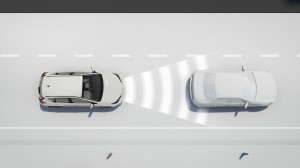
Collision avoidance technology like Toyota's Radar Cruise Control moved a step closer to becoming standard equipment with the new FCC ruling.
The development of autonomous vehicles just got a boost with the Federal Communications Commission’s approval of a larger section of spectrum to be used by radar systems, which are integral to the growth of self-driving vehicles.
Prior to the latest approval, motor vehicles were confined to 1 GHz of spectrum for the introduction and development of collision avoidance and adaptive cruise control and, down the line, self-driving vehicles.
The ruling expands the band that vehicle radars can operate to 5 GHz of spectrum. This will improve lane departure warning, blind spot detection systems, automatic braking and pedestrian detection, the FCC said.
Automakers have been clamoring for more bandwidth in the spectrum to continue the development of self-driving vehicles. This is important as makers are working to make new safety tech standard equipment, such as collision-avoiding braking systems standard equipment by 2022, a move that could eliminate 1 million crashes a year, Reuters reported.
(BMW hopes to stay connected with consumers with new BMW Connected +. For more, Click Here.)
FCC Chairman Ajit Pai said the agency was giving automakers “the bandwidth needed” to allow “proven technologies that enable services like collision avoidance, blind spot monitoring, and lane change assistance” and allow for “new innovations.”
Another upside of the move is that is that it puts spectrum in alignment with European rules. With the playing field the same, automakers can more easily share technologies between continents, bringing the costs down.
The decision will also lead to improved aviation safety by boosting foreign object debris detection radars on airport runways and aircraft wingtip radars that can help avoid collisions with objects while moving on airport grounds, according to Reuters.
(Click Here for details about Toyota’s $100M investment disruptive tech.)
Automakers and suppliers have been pushing for this move for some time now; however, the industry was given a different part of the spectrum years ago. FCC Commissioner Michael O’Rielly voted for the change but noted automakers were granted another block of spectrum in 1999 for vehicle-to-vehicle communications, but it has gone largely unused.
The industry will release its claim to that part of the spectrum as part of the deal. In December, the U.S. Transportation Department proposed requiring future new cars and trucks to be able to “talk” to one another, but it has not been finalized, but it could be folded into this new expanded chunk of the spectrum.
Automakers are pursuing technologies to assist drivers in avoiding crashes while working on fully self-driving cars.
(Honda Accord tops most stolen vehicle list for 2016. Click Here to see the details.)
U.S. traffic deaths rose 8% in the first nine months of 2016. This came after jump in 2015, which marked the biggest jump in four decades: 4% to 6.3 million fatalities, renewing calls for makers to find ways to get this new safety tech into vehicles as standard equipment.
